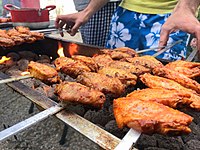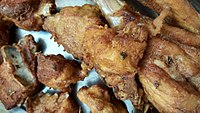
Course
Starter, main meal, side dish
Hot and cold
916 kJ (219 kcal)
3.500 g
4.930 g
2.740 g
0.276 g
1.020 g
1.233 g
1.797 g
2.011 g
0.657 g
0.329 g
0.959 g
0.796 g
1.199 g
1.545 g
0.726 g
1.436 g
2.200 g
3.610 g
1.583 g
1.190 g
0.870 g
Quantity
Quantity
Quantity
63.93 g
Chicken can be prepared in a vast range of ways, including baking, grilling, barbecuing, frying, and boiling. Since the latter half of the 20th century, prepared chicken has become a staple of fast food. Chicken is sometimes cited as being more healthful than red meat, with lower concentrations of cholesterol and saturated fat.[4]
The poultry farming industry that accounts for chicken production takes on a range of forms across different parts of the world. In developed countries, chickens are typically subject to intensive farming methods while less-developed areas raise chickens using more traditional farming techniques. The United Nations estimates there to be 19 billion chickens on Earth in 2011, making them outnumber humans more than two to one.[5]
The modern chicken is a descendant of red junglefowl hybrids along with the grey junglefowl first raised thousands of years ago in the northern parts of the Indian subcontinent.[6]
Chicken as a meat has been depicted in Babylonian carvings from around 600 BC.[7] Chicken was one of the most common meats available in the Middle Ages.[8][9] For thousands of years, a number of different kinds of chicken have been eaten across most of the Eastern hemisphere,[10] including capons, pullets, and hens. It was one of the basic ingredients in blancmange, a stew usually consisting of chicken and fried onions cooked in milk and seasoned with spices and sugar.[11]
In the United States in the 1800s, chicken was more expensive than other meats and it was "sought by the rich because [it is] so costly as to be an uncommon dish."[12] Chicken consumption in the U.S. increased during World War II due to a shortage of beef and pork.[13] In Europe, consumption of chicken overtook that of beef and veal in 1996, linked to consumer awareness of bovine spongiform encephalopathy (mad cow disease).[14]
357 million tonnes of meat were produced in 2021, 53% more than in 2000, with chicken meat representing more than half the increase. Chicken meat was the most produced type of meat in 2021 just ahead of pig meat.[15]
Raw chicken may contain Salmonella. The safe minimum cooking temperature recommended by the U.S. Department of Health & Human Services is 165 °F (74 °C) to prevent foodborne illness because of bacteria and parasites.[36] However, in Japan raw chicken is sometimes consumed in a dish called torisashi, which is sliced raw chicken served in sashimi style. Another preparation is toriwasa which is lightly seared on the outsides while the inside remains raw.[37]
Chicken can be cooked in many ways. It can be made into sausages, skewered, put in salads, traditionally grilled or by using electric grill, breaded and deep-fried, or used in various curries. There is significant variation in cooking methods amongst cultures. Historically common methods include roasting, baking, broasting, and frying. Western cuisine frequently has chicken prepared by deep frying for fast foods such as fried chicken, chicken nuggets, chicken lollipops or Buffalo wings. They are also often grilled for salads or tacos.
Chickens often come with labels such as "roaster", which suggest a method of cooking based on the type of chicken. While these labels are only suggestions, ones labeled for stew often do not do well when cooked with other methods.[38]
Some chicken breast cuts and processed chicken breast products include the moniker "with rib meat". This is a misnomer, as it refers to the small piece of white meat that overlays the scapula, removed along with the breast meat. The breast is cut from the chicken and sold as a solid cut, while the leftover breast and true rib meat is stripped from the bone through mechanical separation for use in chicken franks, for example. Breast meat is often sliced thinly and marketed as chicken slices, an easy filling for sandwiches. Often, the tenderloin (pectoralis minor) is marketed separately from the breast (pectoralis major). In the US, "tenders" can be either tenderloins or strips cut from the breast. In the UK the strips of pectoralis minor are called "chicken mini-fillets".
Chicken bones are hazardous to health as they tend to break into sharp splinters when eaten, but they can be simmered with vegetables and herbs for hours or even days to make chicken stock.
In Asian countries it is possible to buy bones alone as they are very popular for making chicken soups, which are said to be healthy. In Australia the rib cages and backs of chickens after the other cuts have been removed are frequently sold cheaply in supermarket delicatessen sections as either "chicken frames" or "chicken carcasses" and are purchased for soup or stock purposes.
Freezing
Raw chicken maintains its quality longer than fresh in the freezer, as moisture is lost during cooking.[41] There is little change in nutrient value of chicken during freezer storage.[41] For optimal quality, however, a maximum storage time in the freezer of 12 months is recommended for uncooked whole chicken, 9 months for uncooked chicken parts, 3 to 4 months for uncooked chicken giblets, and 4 months for cooked chicken.[41] Freezing does not usually cause color changes in poultry, but the bones and the meat near them can become dark. This bone darkening results when pigment seeps through the porous bones of young poultry into the surrounding tissues when the poultry meat is frozen and thawed.[41]
It is safe to freeze chicken directly in its original packaging, but this type of wrap is permeable to air and quality may diminish over time. Therefore, for prolonged storage, it is recommended to overwrap these packages.[41] It is recommended to freeze unopened vacuum packages as is.[41] If a package has accidentally been torn or has opened while food is in the freezer, the food is still safe to use, but it is still recommended to overwrap or rewrap it.[41] Chicken should be away from other foods, so if they begin to thaw, their juices will not drip onto other foods.[41] If previously frozen chicken is purchased at a retail store, it can be refrozen if it has been handled properly.[41]
Bacteria survives but does not grow in freezing temperatures. However, if frozen cooked foods are not defrosted properly and are not reheated to temperatures that kill bacteria, chances of getting a foodborne illness greatly increase.[42]
Sources
![]() This article incorporates text from a free content work. Licensed under CC BY-SA IGO 3.0 (license statement/permission). Text taken from World Food and Agriculture – Statistical Yearbook 2023, FAO, FAO.
This article incorporates text from a free content work. Licensed under CC BY-SA IGO 3.0 (license statement/permission). Text taken from World Food and Agriculture – Statistical Yearbook 2023, FAO, FAO.






![Chicken tikka masala, adapted from Indian chicken tikka and called "a true British national dish." The dish is now popular staple in Indian restaurants worldwide.[39]](http://upload.wikimedia.org/wikipedia/commons/thumb/f/fd/Chicken_tikka_masala.jpg/133px-Chicken_tikka_masala.jpg)
![A chicken curry from Maharashtra, India with rice flour chapatis. The dish is popular worldwide.[40]](http://upload.wikimedia.org/wikipedia/commons/thumb/6/61/Chicken_preparation_in_Malvani_style.jpg/200px-Chicken_preparation_in_Malvani_style.jpg)



